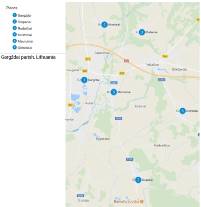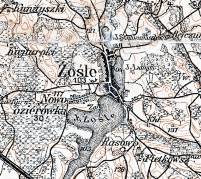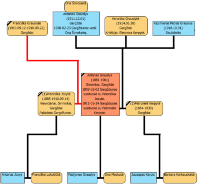GENEALOGICAL RESEARCH - INVESTIGATING YOUR LITHUANIAN ANCESTRY
In order to find out more about your family during the genealogical research and to draw the family relations in the genealogical chart, it is necessary to have the essential facts from the life of the persons involved. The first name and the family name, dates of birth, marriage and death, as well as the place names are considered to be the essential data for personal identification.The sources of such information could be various documents, e.g. records related to baptizing, marriage, death, also, lists of parishioners, estate inventory lists, the population census data, etc.
In our country, the main depository of genealogical sources is the Lithuanian State Historical Archives. The Archives preserve almost all 18th – 20th cc. church record books from Vilnius, Seinai, Telšiai (Samogitia) Roman Catholic dioceses, and the record books of 1924 – 1940 from Panevėžys, Kaunas, Kaišiadorys, Vilkaviškis Roman Catholic churches. These church books contain records of baptisms, marriages and deaths.
The Archives also preserve record books from the churches of other confessions in Lithuania – Russian Orthodox, Old Believers, Jewish, Evangelical Reformed, Lutheran, Moslem, Karaite – with birth, marriage, divorce and death records. There are also documents of the civil marriage registry offices of 1940 – 2007, documents of the Chancellery of the Convention of the Nobility Representatives of the Vilnius Governor-ate, of custodial institutions of the nobility and their leaders of the Vilnius and Kaunas counties of these govern-orates, documents of the Augustavas County nobility leader, also private collections and collections belonging to different families.
These are the main genealogical sources of the 18th – 20th cc. preserved in the Lithuanian State Historical Archives:
- Birth, marriage, divorce and death church records books of various confessions,
- Pre-marital questioning books,
- Lists of parishioners,
- Acts verifying the nobility,
- Lists of noble families,
- Estate inventory lists,
- Lists of auditing,
- Birth, marriage, divorce, death civil registries, etc.
Documents, the access to which is not restricted by the law, are accessible in the reading rooms of the archives for the research into the original documents and digital document copies. There are 4,758 digital copies of the files containing fonds of various churches and nobility offices, available on the Intranet of the Archives.
These are the main genealogical sources of the 20th c. preserved in the Lithuanian Central State Archives:
Domestic and foreign passports of the citizens of the Republic of Lithuania,
Documents of volunteers, conscripts, soldiers and officers of the Army of the Republic of Lithuania,
Documents referring to the land reform,
Personal files of teachers, pupils and students,
Documents of persons abducted as forced laborers to Germany,
The population census data from 1942 and 1959, and others.
It should be noted that the access to many 20th c. genealogical sources preserved in the Lithuanian State Historical Archives is restricted by the law.
Genealogical sources are being preserved not only in the state archives but also in libraries and museums. In the Manuscript Department of the Vilnius University Library, there are record books of some Roman Catholic churches and 230 personal colections preserved; in the Manuscript Department of the Wroblewski Library of the Lithuanian Academy of Sciences, there are record books of some churches and inventory lists of Lithuanian estates preserved; at the Rare Book and Manuscript Department of the Martynas Mažvydas Lithuanian National Library of Lithuania, there are record books of some Telšiai (Samogitian) diocese churches preserved.
Electronic Depositories
For genealogical search, people often use various data bases and information provided by the virtual archives. “Epaveldas” www.epaveldas.lt is the biggest data base in Lithuania, where one can obtain genealogical information. At present, one can find digital images of 2,312 record books from 91 Lithuanian Roman Catholic churches in the data base of this website. They relate to the period of 1599 – 1940. As the process of digitization of the document files continues, the data base is constantly expanding. The complete list of all Roman Catholic church record books that had already been, or are being digitized can be found on the website of the Office of the Chief Archivist of Lithuania www.http://www.archyvai.lt.
Before you start genealogical search, it is vital to collect the essential information relating to the person in search:
his/her date of birth, place of birth, the birth order (a person's rank by age among his or her siblings), the church he/she was baptized; the date of marriage, the name of the spouse, the church he/she was married in; the date and the place of his/her death, etc. This kind of information can be easily obtained by questioning older relatives and members of the family. The accumulated information is checked and specified during the investigation of the church record books.
Beginning with the 17th c. and up to 1827, all recordings in the church record books were made in Latin, from 1828 and until the middle of the 19th c. – they were made in Polish, from the middle of the 19th c. until 1920 – in Russian, during the World War I – in German (in most parishes), after the war – in Lithuanian in Telšiai Diocese, and both in Latin and Polish in Vilnius Diocese. Therefore, both personal names and place names in some documents were either "Polonized" or "Russified": e.g., the family name Arlauskas appears in the documents as Orlowski or Орловский, the first name Jurgis appears as Jerzy or Георгий, Юрий; in the same way, the first name Laurynas appears as Wawrzyniec or Лаврентий; the place name Varėna – as Orany or Ораны; the place name Zarasai – as Jeziorosy or Ново Александровск, etc., etc.
When making a Genealogical Chart, it is recommended to adhere to certain rules:
The Genealogical Chart of the family is made displaying the names of the persons and dates of their birth/death; if needed, the name of the birth place might be included as well.
When making the Genealogical Chart, it is important to observe the rule of the chronology of generations, which requires placing the persons belonging to the same generation on the same level.
The display of the persons in the Genealogical chart is made from left to right. The elder children are entered on the left side, while the younger ones – on the right. Provided one knows the rule of the chronological placement of the persons, he/she can easily identify the eldest or the youngest child in the family, even without knowing the exact birth dates of the children.
The male line of the family must be drawn on the left, while the maternal line – on the right. The matrimonial link between a man and a woman is reflected by inserting the date and the place of their marriage. It is essential to enter the woman‘s maiden name next to her name.
If you have any additional questions about genealogical research of your Lithuanian ancestry or you already decided you need the help of our researchers - do not hesitate to contact us now! We are here to advise, guide and provide the service that you need.




